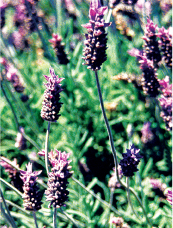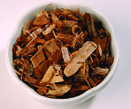Nature's soothing power
Natural holistic herb treatments might work as remedies for back aches. Essential oils are used topically to relax, relieve tension and improve the overall health. We've put together a guide of Essential Oils from A to Z to know what essentials may work for you.
+ The following are effective medical plants and herbal remedies used to fight back pains and ailments. Some plants may be easier to find than others depending on where the plants are cultivated. You can find some as fresh plants or dried, and others in liquid form, tinctures, tablets or powder.
NOTE
You should always consult your physician before starting any herbal treatment.
Devil's claw

INFUSION TO FIGHT PAIN
To make the infusion add 3 medium spoonfuls of devil's claw root to 1 cup of water. Boil for 3 minutes. Let sit between 10 to 15 hours. You should drink this tincture 3 times a day, 10 minutes before meals.

(Harpagophytum procumbens)
• Parts used. The secondary storage roots, which form rings when dried. They are used in infusions, to make extracts and mother tinctures.
• Native to Southwestern Africa, the name comes from the curious shape of its fruit.
• Possesses anti-inflammatory and analgesic properties. Numerous tribes native to Southern Africa have utilized devil's claw for a wide variety of conditions, ranging from gastrointestinal difficulties to arthritic conditions. Devil's claw has been widely used in Europe as a treatment for arthritis.
• Warning. Pregnant women should not use this remedy. Since devil's claw promotes stomach acid, anyone with gastric or duodenal ulcers should not use the herb.

AROMATHERAPY
Physical and psychic remedy, using essential oils. Essential oils are extracted from plants, flowers, trees, and roots and processed by grinding, distillation, or extracted with a dissolvent. Although modern aromatherapy is thought of as a technique to care for the body with pleasant smells, this ancient healing art uses essential oils for their therapeutic properties.
Some uses for essential oils: rub into skin during massages, put a few drops when taking a bath and add to vapors for inhaling. Using oils in massage therapy is the most common use because it awakens the sense of smell, softens the skin and makes the massage feel even more relaxing.
There are a number of essential oils specifically indicated for back pain. Blend and dilute with sweet almond oil or grape seed oil (see Essential oils from A to Z box).
ESSENTIAL OILS FROM A TO Z
BLACK PEPPER
Intense and spicy aroma. This essential oil stimulates circulation, which makes it perfect for relieving pains brought on by exerting physical force.
Safety. It is recommended to use in low doses because it can irritate the skin.
CAMOMILE
There are many varieties, among those made with the common Roman camomile. Because of its soothing and anti-inflammatory properties, it's great for stubborn pains, such as back pain. It blends well with ylang ylang.
Safety. It shouldn't be used during the first four months of pregnancy. In large doses it can have a hypnotic effect and produce drowsiness, although it is not a depressant. Combine with bergamot, geranium, jasmine, lavender and ylang ylang.
WARNING
Essential oils are for external use only , they should never be ingested. Keep stored away from children and keep away from your eyes.
Lavender

(Lavandula officinalis)
• Parts used. Flowers and leaves, and sometimes the stems are used to prepare infusions or to make essential oils and tinctures.
• Native to Europe and North Africa. Today, it's cultivated in a number of countries, such as France and the US. In addition, it leaves a lovely, floral scent. The leaves can be added to salads, to substitute for mint.
• Today, lavender is used against headaches, depression and insomnia. This plant has calming and relaxing properties. It can be used as an essential oil for baths or the herb can be used to make decoctions.
SOOTHING LAVENDER TEA
Place 2 teaspoons of lavender leaves in 1 cup of boiling water. Let it steep for 15 minutes. You can drink up to 3 cups per day.

Passion Flower
(Passiflora coerulea)
• Parts used. The flowers and leaves are used in infusions. The fruit is edible.
• Passiflora coerulea originated in the Americas. A species with similar characteristics, is grown in Europe. The plant was brought to Europe by the Spanish conquistadors, who saw in the flower the marks of the passion of Christ (hence the name).
• One of the best remedies against nervous ailments, it doesn't have any side effects. Passion flower has sedative and soothing properties, but not depressive. It also makes you sleepy. Ideal for work related stress and mood swings and nervousness brought on by premenstrual syndrome and menopause.
• Warning. Do not use passion flower if you are pregnant or breast-feeding. Do not administer to children under age of 3 years old. For children between 4 and 12 years of age, consult a medical specialist, because the dose should be proportioned to weight of the child. Eat passion fruit only when very ripe, because the fruit has toxic properties before ripening.

ESSENTIAL OILS FROM A TO Z
CINNAMON
This warming oil has invigorating properties, especially recommended for muscular pain. Blends well with citrus essential oils like orange.
Safety. You should always purchase cinnamon oil made from cinnamon tree leaves, because cinnamon bark can irritate the skin. Essential oils made from the leaves should be used in low doses.
GRAPEFRUIT
It is useful in fighting fatigue, because of its stimulating and revitalizing properties. Sweet and citrus aroma, blends well with camomile, lavender and orange.
Safety. It should be used in low dilutions. Avoid direct sunlight after using this oil.
Cayenne Pepper
(Capsicum frutescens)

• Parts used. The leaves and fruit are used in tincture and powders.
• There are at least 40 species of capsicum native to Central and South America. The fruit is a cylindrical strip of red or yellow color when ripe. The taste is very hot and spicy. It has been used since pre-Hispanic times as a food, medicine and ceremonial ingredient.
• Among its many properties, it's a pain reliever, anti-inflammatory, and antiseptic. It is recommended for swelling, bruising, rheumatism and herpes.
White willow
(Salix alba)
• Parts used. The leaves, roots and the bark are used and cultivated in the spring.
• It grows in central and continental Europe, although it's also found in North America. Grows in the wild along rivers, streams, forests and in other humid environments.
• Among its active components, salicin is the most important for its pain relieving, sedative, anti-rheumatic and anti-fever properties.

RELIEVING TINCTURE
To take advantage of the pain relieving properties of cayenne pepper, you should let a whole pepper, fruit and seeds ferment in alcohol for 5 hours. Then apply this relieving liquid to the affected area. Avoid touching your eyes, mouth or genitals. Pepper irritates open wounds.
ANTI-STIFFNESS EXTRACT
White willow extract can be found in specialized stores. The dose for average adults is between 60 and 120 mg a day.
• Warning. People who are allergic to aspirin (acetyl-salicylic acid) or other similar medicines should not use white willow. It shouldn't be used on pregnant women or children.
ESSENTIAL OILS FROM A TO Z
LAVENDER
This is one of the most versatile and widely used oils. Its pain relieving properties are recommended for muscular pain. It also helps to balance the emotions, because it allows you to release tension. Its clean and floral aroma has sedative effects.
Safety. Do not use this oil during the first three months of pregnancy.
MARJORAM
Has pain relieving properties and increases local circulation. The aroma is intense and almond like.
Safety. Shouldn't be used during pregnancy.
European Meadowsweet
Filipendula ulmaria)
• Parts used. The flowers and the leaves are sometimes used in decoctions.

• It grows in humid areas throughout Europe, except in the Mediterranean. It also grows in some of the northern, cold areas of North America.
• Anti-inflammatory, pain relieving and fever fighting, it can be used against back aches, neck pains and other ailments such as sciatica rheumatoid arthritis, neuralgia and other problems caused by uric arthritis or gout.

Cat's claw
(Uncaria tomentosa)
• Parts used. The bark of the roots is used in infusions, tinctures or dried extract.
• It grows in the tropical, mountainous Andes region in South America, especially Peru.
• It has anti-inflammatory and antioxidant properties and is recommended for inflammations, arthritis, rheumatism, and tumors. It is also considered a healing agent.
• Warning. It should be used with precaution during pregnancy.

Valerian
(Valeriana officinalis)
• Parts used. The roots are used in extracts and tinctures.
• It grows wild all over Europe and in most cases valerian is cultivated to make medical extracts.
• It's a sedative, which is why it is indicated to relieve tense muscles and neck pain, and upper back pain caused by stress.
• It doesn't present any side effects.

ESSENTIAL OILS FROM A TO Z
ORANGE
Sweet, fruit aroma, it's one of the most relaxing citrus oils. Comforting and stimulating, relieves muscular pains and is very useful in baths during the winter.
Safety. You should use it in low doses because it can irritate the skin.
ROSEMARY
Especially recommended for intense pain. It is an intense oil with a clean, herbal aroma. It can help to stimulate your energy when you're energy level is low. It is also an astringent, and contributes to tightening of the skin and pores. It blends well with basil, bergamot, myrrh, and lavender.
Safety. Shouldn't be used during pregnancy. If you suffer from epilepsy or high blood pressure, avoid this oil.

Comment about this article, ask questions, or add new information about this topic: